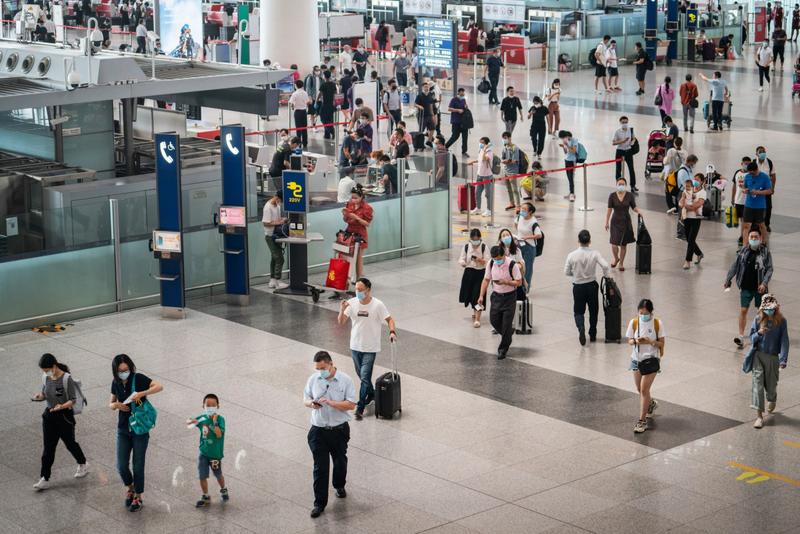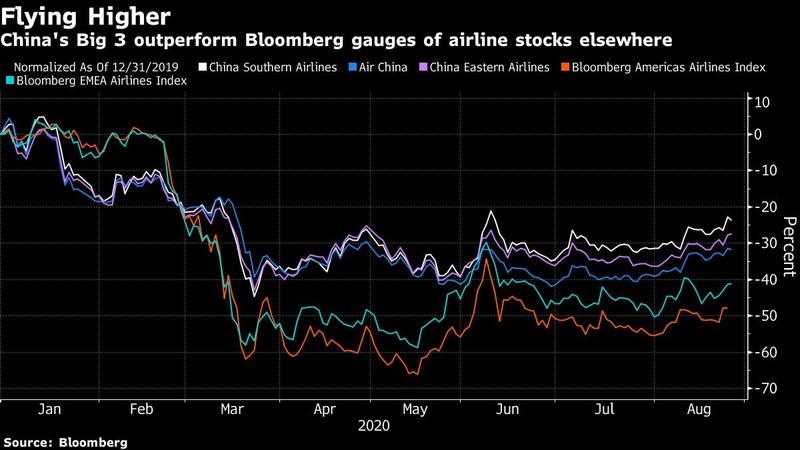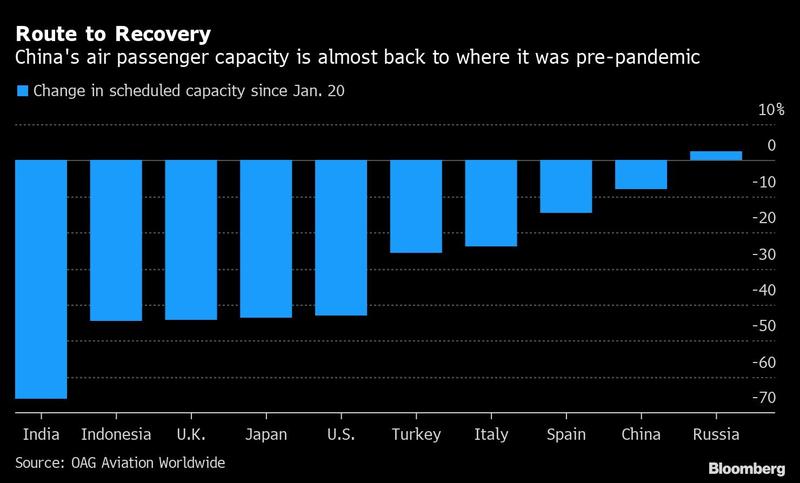 This Aug 25, 2020 photo shows passengers at Beijing Capital International Airport in Beijing. (PHOTO/BLOOMBERG)
This Aug 25, 2020 photo shows passengers at Beijing Capital International Airport in Beijing. (PHOTO/BLOOMBERG)
China’s biggest airlines could provide some much-needed encouragement for an aviation industry starved of good news when they report earnings later this week.
While the coronavirus will still likely saddle Air China Ltd, China Eastern Airlines Corp and China Southern Airlines Co with losses for the latest quarter, financial statements from the so-called Big 3 may point to a nascent recovery in air travel thanks to demand in their vast domestic market.
READ MORE: Foreign airlines resuming flights to China as travel curbs ease
July traffic figures were promising, with passenger numbers for the three airlines rising about 25 percent from June as travel within China picked up. The trio flew a total of 22 million passengers domestically last month, more than 500 times as many flown at all by Hong Kong-based Cathay Pacific Airways Ltd, which has no home market to fall back on. Revenue passenger kilometers also jumped, though the numbers remain far below a year ago, pre-pandemic.

After being the first hit by COVID-19, China is emerging from the crisis; it’s the only major economy on track to expand this year. Businesses have reopened and people are traveling again after the government eased restrictions on movement, including for inter-provincial group tours. The FTSE China A 600 Travel & Leisure Index has climbed more than 50 percent in three months.
Popular Chinese destinations include Jiuzhaigou, famous for its colorful lakes, and Yangshuo and cities such as Chengdu, Shanghai and Beijing. Some places are receiving almost three times the number of visitors than last quarter, HSBC Holdings Plc analysts led by Parash Jain wrote in a note dated Aug 17, citing Trip.com data. Hotels have also become busier after the curbs were lifted. Occupancy rates in Shanghai reached 65.8 percent in the Aug 9-15 week compared with just 6 percent in February, according to local government data.

“This should boost load factors further and allow airlines to improve yields, a key profit driver,” Jain said, noting that Chinese mainland carriers generate most profit on domestic routes. “Domestic traffic has been consistently showing signs of a recovery, while international traffic has still to take off meaningfully due to hurdles from travel restrictions and quarantine requirements,” he said.
Domestic traffic has been consistently showing signs of a recovery, while international traffic has still to take off meaningfully due to hurdles from travel restrictions and quarantine requirements.
Parash Jain, HSBC Holdings analyst
Some carriers including China Eastern have offered ticket deals that allow unlimited flights, sacrificing some of their bottom line to lure customers back. OAG Aviation Worldwide said scheduled capacity in Asia’s biggest economy reached 15.6 million seats this week, only around 8 percent lower than toward the end of January when the outbreak began. By contrast, US capacity is still down 43.1 percent from January at 11.8 million seats.
Jain said passenger capacity could grow this month compared with August last year, a striking turnaround given how hard the virus hit. The damage has been so grave that the International Air Transport Association doesn’t expect the world’s airlines to recover to pre-pandemic levels before 2024.
While the July traffic reports from the Big 3 showed an improvement at home, their international passenger traffic was still down 96 percent or more from a year earlier. The carriers also took a beating in the first quarter with a combined loss of 14 billion yuan (US$2 billion) and, according to Jain, they’re headed for a full-year loss of 24.2 billion yuan.
Cheap jet fuel
Second-quarter figures, which the three are due to release Friday, should show an improvement from January-March thanks to higher passenger traffic and the yuan’s resilience against the dollar, Jain said.
Lower oil prices could also help numb some of the pain. Jet fuel fell to less than US$20 a barrel in May and is likely to average US$45 in 2020, according to Paul Yong, a Singapore-based aviation analyst at DBS Group Holdings Ltd.
“With revenue from domestic routes making up about two-thirds of total revenue for China’s Big 3 and with relatively low jet fuel prices, this should help them outperform their Asian peers that have higher international route exposure,” Yong said.
ALSO READ: China's major airline sees traffic rebound in April
Yong has buy ratings on the Hong Kong-listed shares of all three carriers, as well as the mainland-listed stock of Air China and China Eastern. He has a hold recommendation on China Southern’s Shanghai-listed shares. The Big 3 are overwhelmingly rated buy or equivalent by analysts tracked by Bloomberg.
Shanghai-based Spring Airlines Co has also had a strong run on the stock market, outperforming all others on a gauge of carriers in the Asia-Pacific region with a gain of 20 percent so far this quarter. The budget airline is also due to report earnings at the end of this week.


